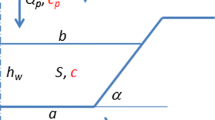Abstract
Field-scale solute transport experiments are not easily implemented because of the overwhelming problems of soil heterogeneity and variability in subsurface hydraulic and solute transport properties. In this paper, the results of four field-scale furrow irrigation experiments designed to investigate the effect of flow depth and solute application time on bromide distribution along and below the furrows are presented. One experiment was conducted under free-draining (FD) conditions in which bromide was applied during the entire irrigation event. Three experiments were carried out in blocked-end furrows in which bromide was injected either during the entire irrigation event (100%), the first half of the irrigation (FH), or the second half of the irrigation (SH). The FD experiment was equipped with neutron probe tubes for measuring soil water contents at different times and locations in furrow cross-section whereas soil samples for bromide analysis and gravimetric soil water contents from all the experiments were collected at different depths up to 1.80 m, 5 days after the irrigation at three locations near the inlet, in the middle, and close to the outlet of the furrows. Overland flow depths along the furrows were also recorded using staff gauges at the inlet, middle, and outlet sites every few minutes during the entire irrigation. Results showed substantial non-uniformity in solute movement along the monitored furrows, with the degree of non-uniformity depending upon flow depth and solute application time. Non-uniform distributions were observed especially at the outlet sites, compared with those at the inlet and middle sites. Solute application efficiencies for the FD, 100%, FH, and SH experiments were 50, 100, 64, and 93%, respectively. The effects of flow depth and irrigation/solute application time on soil water contents were more pronounced in the soil surface layers and were found to be relatively minor at deeper depths. Water and solute deep percolation rates also showed dependency to flow depth and solute application/opportunity time and gradually decreased along the furrows.









Similar content being viewed by others
References
Abbasi F, Adamsen FJ, Hunsaker DJ, Feyen F, Shouse P, Genuchten MT van (2003a) Effects of water depth on water flow and solute transport in furrow irrigation: field data analysis. J Irrig Drain Eng ASCE 129
Abbasi F, Simunek J, Genuchten MT van, Feyen J,Adamsen FJ, Hunsaker DJ,Strelkoff TS, Shouse P (2003b) Overland water flow and solute transport: model development and field-data analysis. J Irrig Drain Eng ASCE 129:71–81
Biggar JW, Nielsen DR (1976) Spatial variability of the leaching characteristics of a field soil. Water Resour Res 12:78–94
Dam JC van, Stricker JNM, Droogers P (1994) Inverse method to determine soil hydraulic functions from multistep outflow experiments. Soil Sci Soc Am J 58:647–652
Eching SO, Hopmans JW, Wallender WW (1994) Estimation of in situ unsaturated soil hydraulic functions from scaled cumulative drainage data. Water Resour Res 30:2387–2394
Garcia-Navarro P, Playan E, Zapata N (2000) Solute transport modeling in overland flow applied to fertigation. J Irrig Drain Eng ASCE 126:33–40
Genuchten MT van (1980) A closed-form equation for predicting the hydraulic conductivity of unsaturated soils. Soil Sci Soc Am J 44:892–898
Genuchten MT van, Leij FJ, Wu L (eds) 1999 Proceedings of the international workshop: Characterization and measurement of the hydraulic properties of unsaturated porous media, parts 1 and 2. University of California, Riverside, Calif., USA
Golden Software (1999) Surfer version 7.0: contouring and 3D surface mapping for scientists and engineers. Golden Software, Colo., USA
Jury WA (1985) Spatial variability of soil physical parameters in solute migration: a critical literature review. EPRI EA-4228 project 2485-6, Riverside, Calif., USA
Mallants D, Mohanty BP, Jacques D, Feyen J (1995) Spatial variability of hydraulic properties in a multi-layered soil profile. Soil Sci 161:167–181
Mohanty BP, Ankeny MD, Horton R, Kanwar RS (1994) Spatial variability of hydraulic conductivity measured by disc infiltrometer. Water Resour Res 30:2489–2498
Nielsen DR, Biggar JW, Erh KT (1973) Spatial variability of field-measured soil water properties. Hilgardia 42:215–260
Playan E, Faci JM (1997) Border irrigation: field experiment and a simple model. Irrig Sci 17:163–171
Simunek J, Sejna M, Genuchten MT van (1999) The HYDRUS-2D software package for simulating the two-dimensional movement of water, heat, and multiple solutes in variably saturated media, Version 2.0. IGWMC-TPS-70, International Ground Water Modeling Center, Colorado School of Mines, Golden, Colo., USA
Acknowledgements
The authors gratefully acknowledge the support of the SAHRA Science and Technology Center under a grant from NSF (EAR-9876800). The authors would also like to express their gratitude to three anonymous referees for many useful comments and suggestions.
Author information
Authors and Affiliations
Corresponding author
Rights and permissions
About this article
Cite this article
Abbasi, F., Feyen, J., Roth, R.L. et al. Water flow and solute transport in furrow-irrigated fields. Irrig Sci 22, 57–65 (2003). https://doi.org/10.1007/s00271-003-0070-x
Received:
Accepted:
Published:
Issue Date:
DOI: https://doi.org/10.1007/s00271-003-0070-x




